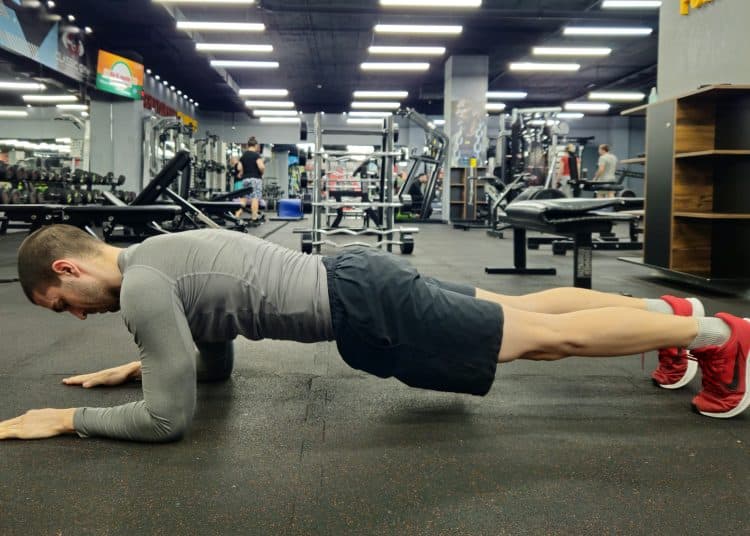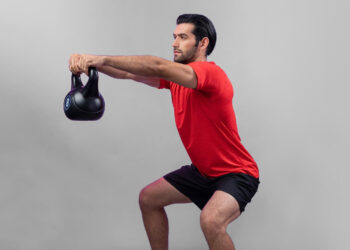I’ve been teaching circuit training for almost 40 years. In fact, my first job in the fitness industry was as a circuit training instructor. However, I actually started circuit training about five years earlier, when it was a part of my strength and conditioning workouts as an up-and-coming high school athlete.
Since then, I’ve used circuit training to help many of my clients reach their health, fitness, and body composition goals. It regularly features in my own workouts, too. Additionally, I’ve taught dozens of circuit training courses to prospective instructors.
Long story short, I’m something of a circuit training expert, having spent decades studying and utilizing this powerful and versatile training method.
Unfortunately, many people don’t know how effective and beneficial circuit training can be. That’s probably because circuit training is quite old-school and can even seem outdated compared to things like HIIT and other high-tech workouts.
With that in mind, in this article, I reveal the science-backed benefits of circuit training. When you see how effective circuit training is, I’m confident you’ll want to try it yourself.
What is Circuit Training?
Level Up Your Fitness: Join our 💪 strong community in Fitness Volt Newsletter. Get daily inspiration, expert-backed workouts, nutrition tips, the latest in strength sports, and the support you need to reach your goals. Subscribe for free!
Before we delve into the benefits of circuit training, let’s take a moment to define what circuit training is and provide you with a sample workout to try.
Circuit training has been around for thousands of years and was practiced by both the ancient Romans and Greeks. However, it was first formally studied in the 1950s at Leeds University in the UK by R.E. Morgan and G.T. Anderson (1).
But what is circuit training?
While there are numerous ways to do circuit training, the most fundamental versions involve doing multiple exercises back-to-back. In circuit training, exercises are called stations, and you do each one for a predetermined time or number of reps.
While there is no set number of stations for circuit training, 6-12 is typical. Most circuit workouts involve doing multiple rounds of the stations, usually 2-5. Rests (called transitions) between stations are generally kept short, but you get a longer break between rounds, usually 1-3 minutes.
Why all this unusual fitness lingo? The original circuits were arranged around the outside of sports halls, so you moved around the room, transitioning from one exercise to the next. So, terms like stations and rounds make sense, right?
Anyway, circuit training can involve a few or many different types of training equipment or none at all. Calisthenic or bodyweight circuits are especially popular in the military.
Here’s a typical mixed modality circuit training example. Do each exercise for 45 seconds, taking no more than 10-15 seconds to transition from one to the next. Perform three rounds and rest for 1-2 minutes between each round.
- Goblet squats
- Push-ups
- Planks
- Alternating lunges
- Inverted rows
- W-sits
- Kettlebell swings
- Dumbbell curl and press
- Twisting oblique crunch
- Box jumps
- Narrow push-ups
- Prone superman
Note the lower body, upper body, and core sequence of the stations. This order ensures that all major muscle groups are trained equally and that you can maintain a brisk pace for the duration of the workout. In contrast, doing similar exercises back-to-back creates a lot of localized fatigue, invariably hampering workout performance.
Related:
- What is Circuit Training? The Ultimate Guide to Get Lean
- Integrated Circuit Training for Fitness and Fat Loss
The Science-Backed Benefits of Circuit Training
Now you understand how circuit training works, let’s look at the benefits of this proven training method!
1. Weight Management
The non-stop nature of circuit training means that energy expenditure is higher than for conventional strength training. While the actual kilocalorie cost will depend on the duration and intensity of your workout, studies indicate that circuit training can help you lose or maintain your weight (2).
Using large compound exercises, working hard, and keeping your rest periods to a minimum will all raise your energy expenditure, leading to faster weight loss.
Use this calculator to estimate how many kilocalories you’ll burn during a circuit training workout.
2. Improved Cardiovascular Fitness
While some circuit training workouts involve short bouts of cardio, e.g., jump rope, sprints, etc., most revolve around strength training exercises, e.g., push-ups, lunges, and pull-ups. However, despite this, circuit training has been shown to enhance cardiovascular fitness, measured by increases in participants’ VO2 max (3).
So, whether you don’t have time to do much cardio or find things like running and cycling boring, it’s reassuring to know that circuit training will enhance your cardiovascular fitness and, therefore, improve your heart, lung, and circulatory health (4).
3. Increased Muscular Endurance, Strength, and Power
When most people talk about fitness, they’re referring to their heart, lungs, and circulatory system. However, you can use the term fitness in relation to the functional capacity of your muscles, too.
Broadly speaking, there are three types of muscular fitness (5).
Level Up Your Fitness: Join our 💪 strong community in Fitness Volt Newsletter. Get daily inspiration, expert-backed workouts, nutrition tips, the latest in strength sports, and the support you need to reach your goals. Subscribe for free!
Muscular endurance is the ability of your muscles to generate low amounts of force for a prolonged period. It’s best developed by doing high-rep sets interspersed with short rests.
In contrast, muscular strength is the ability to generate lots of force for a relatively short time. Lifting heavy weights is an example of this.
Muscular power is a force produced quickly. Also known as explosive strength, power is an integral part of most sports. Activities requiring power include sprinting, jumping, kicking, throwing, and punching.
You can use circuit training to enhance all types of muscular fitness. You just need to plan your workout accordingly. However, most circuit workouts focus on endurance, as this is arguably the most straightforward type of muscular fitness to program and develop.
4. Improved Mood
Circuit training combines strength training with cardio to deliver a comprehensive workout. However, while circuit training is excellent for your physical fitness and health, it’s good for your brain, too.
Studies suggest that cardio and strength training can enhance your mood and lower stress and anxiety (6). Circuit training is also empowering, making participants feel less overwhelmed by challenging situations. If you can cope with the demands of a tough circuit workout, you can cope with anything!
While circuit training is not a cure-all for all mental health issues, it’s reassuring to know that it’s good for both your body and brain. As the saying goes, mens sana in corpore sano, which is Latin for a healthy mind in a healthy body.
5. Increased Exercise Adherence
Even the best workout isn’t worth the paper it’s written on if you don’t do it regularly. Consequently, exercise adherence is critical for building fitness and strength and effective weight management.
While conventional strength and cardio training are undeniably effective, some people find them too regimented, repetitive, and boring. As such, they soon lose motivation to work out (7). Exercise drop-out is very common, especially around February/Match time, when most New Year’s Resolutions are left for dead.
Circuit training is highly variable, and there is no reason to repeat a workout if you don’t want to. It can also be fine-tuned to match your fitness goals and cater to your exercise likes and dislikes.
As such, circuit training could be the ideal workout for those who struggle to exercise consistently. You can participate in circuits in a group class at a gym or sports center or do circuit workouts alone at home. Such versatility means that exercise enjoyment and adherence should be high.
6. Time-Efficient Workouts
Most well-rounded fitness routines involve strength training and cardio. However, doing separate programs for each fitness component is time-consuming and requires frequent workouts. For example, you might lift weights Monday, Wednesday, and Friday and then jog, cycle, or swim Tuesday, Thursday, and Saturday.
In contrast, circuit training builds muscular and cardiovascular fitness at the same time, making it much more time-efficient.
Subsequently, you’ll need fewer workouts per week to achieve similar results. This time-saving benefit is especially strong if you focus on full-body circuits and don’t just do core or push-up circuits, which were popular when I was a Royal Marine.
Lack of time is a significant barrier to consistent exercise (8). Circuit training is one of the best ways to overcome this problem.
7. Suitable for All Fitness Levels and Goals
Circuit training is very versatile, and workouts can be adjusted to meet almost all levels of fitness and any training goal. The main variables of circuit training are:
- Exercise difficulty
- Number of exercises per workout
- Duration/number of reps
- Load
- Proximity to failure
- Rest between exercises
- Number of rounds
- Rest between rounds
Modifying these variables allows you to create the perfect workout for your needs and goals. Very few other workouts offer the same flexibility. Consequently, you can keep using circuit training for your entire fitness journey, as it’s a workout that grows with you.
Circuit Training Benefits – Closing Thoughts
The fitness principle of specificity states that your body adapts to the type of workout you do.
Therefore, to build massive muscles, you should train like a bodybuilder. On the flip side, powerlifting is probably the way to go if you want to get super-strong. Then again, if you want to improve your cardiovascular fitness, you’ll need to dedicate your energy and time to cardio.
However, if like many exercisers, you want to be fit, strong, lean, and healthy, circuit training is one of the best options. While circuit training won’t maximize your muscle size, strength, or fitness, it will deliver impressive gains in all these areas, making you all-around fit and strong.
Not sure if circuit training is for you? I suggest you try it for a month and experience the transformative power of this workout for yourself.
You’ll find more information on circuit training here.
Related:
- Circuit Training vs. HIIT For Fitness and Fat Loss
- Circuit Training vs. Cross Training: Definitions, Benefits, and Which Should You Do?
References:
- University of New Mexico: New Insights into Circuit Training, Len Kravitz, Ph.D.
- Sperlich B, Wallmann-Sperlich B, Zinner C, Von Stauffenberg V, Losert H, Holmberg HC. Functional High-Intensity Circuit Training Improves Body Composition, Peak Oxygen Uptake, Strength, and Alters Certain Dimensions of Quality of Life in Overweight Women. Front Physiol. 2017 Apr 3;8:172. doi: 10.3389/fphys.2017.00172. PMID: 28420999; PMCID: PMC5376588.
- Muñoz-Martínez FA, Rubio-Arias JÁ, Ramos-Campo DJ, Alcaraz PE. Effectiveness of Resistance Circuit-Based Training for Maximum Oxygen Uptake and Upper-Body One-Repetition Maximum Improvements: A Systematic Review and Meta-Analysis. Sports Med. 2017 Dec;47(12):2553-2568. doi: 10.1007/s40279-017-0773-4. PMID: 28822112.
- Benck LR, Cuttica MJ, Colangelo LA, Sidney S, Dransfield MT, Mannino DM, Jacobs DR Jr, Lewis CE, Zhu N, Washko GR, Liu K, Carnethon MR, Kalhan R. Association between Cardiorespiratory Fitness and Lung Health from Young Adulthood to Middle Age. Am J Respir Crit Care Med. 2017 May 1;195(9):1236-1243. doi: 10.1164/rccm.201610-2089OC. PMID: 28248551; PMCID: PMC5439017.
- Suchomel TJ, Nimphius S, Bellon CR, Stone MH. The Importance of Muscular Strength: Training Considerations. Sports Med. 2018 Apr;48(4):765-785. doi: 10.1007/s40279-018-0862-z. PMID: 29372481.
- Lane AM, Lovejoy DJ. The effects of exercise on mood changes: the moderating effect of depressed mood. J Sports Med Phys Fitness. 2001 Dec;41(4):539-45. PMID: 11687775.
- Rodrigues F, Teixeira DS, Neiva HP, Cid L, Monteiro D. Understanding Exercise Adherence: The Predictability of Past Experience and Motivational Determinants. Brain Sci. 2020 Feb 12;10(2):98. doi: 10.3390/brainsci10020098. PMID: 32059352; PMCID: PMC7071831.
- Pellerine LP, Bray NW, Fowles JR, Furlano JA, Morava A, Nagpal TS, O’Brien MW. The Influence of Motivators and Barriers to Exercise on Attaining Physical Activity and Sedentary Time Guidelines among Canadian Undergraduate Students. Int J Environ Res Public Health. 2022 Sep 27;19(19):12225. doi: 10.3390/ijerph191912225. PMID: 36231525; PMCID: PMC9566408.












